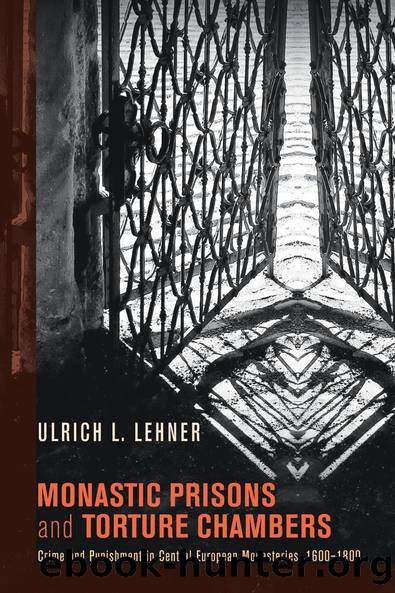Monastic Prisons and Torture Chambers by Lehner

Author:Lehner [Lehner]
Language: eng
Format: epub
Tags: Religion, Christianity, History, Christian Theology, Ethics, General
ISBN: 9781625640406
Google: 69BNAwAAQBAJ
Publisher: Wipf and Stock Publishers
Published: 2013-10-22T03:43:02+00:00
5
Physical Assault and Assassination Attempts in Female Convents
Slaps or fistfights were no minor offenses but were treated as some of the most severe cases that could occur. Hitting a clergyman was punished with excommunication (major ban) outside the cloister and prosecuted inside with no less rigor. The Piarists (1617) are a post-Tridentine order that had regulations similar to those of the Franciscans. For them, even light slaps (leviter percutere) were punished with at least one month in prison for the first offense. If one used a piece of wood or a stone to hit a fellow religious and caused a serious wound, the punishment was six months; for other grave wounds, a year.191 Generally, the more severe the physical harm inflicted upon a religious, the more severe was the punishment. For example, if an attack resulted in mutilation or death, the attacker had to be condemned to galley service.192 When the archbishop of Mainz investigated the harshness of the Franciscan criminal practice in 1770, the friars stated that their legal texts did not contain any such punishments. They insisted that such regulations were only contained in fifteenth-century statutes, only in use in Spain. This was a lie since the canonical texts were equally binding for the Franciscans of Germany!193 Orders that were involved in healthcare also took precautions in their legal documents to deal with cases in which a member of their order gave medical counsel for an abortion or conducted it, at any stage of the pregnancy. If the fetus died, the religious was charged with homicide.194 The Camillians punished even the mere possession of weapons with prison.195
Less harsh punishments were used for nuns.196 Not only was every layperson who hit a nun harshly punished by a secular court, but also every nun, but of course by an ecclesiastical court only. The same was also true if she threw a book or stone and hit another sister. Preparing poison to sicken or kill a religious was ranked among the most severe cases, but even more brutal crimes happened. In 1683 in the Norbertine convent of ÅÄczyca, Poland, Beata Garwanksa smashed the prioressâ head with a bed-warming stone and afterwards smothered the still-breathing nun because she had discovered her secret love for the confessor of the cloister.197 The only licit way of hitting a nun was in self-defense or for correction, but only if applied by the rightful person. Novices could be hit by any professed sister, while among the nuns only the abbess or her delegate had this privilege. In all other cases, an assaulting nun was excommunicated.198
A good example of violence and mild punishment in a female convent comes from Oberwerth near Coblenz, Germany. A Benedictine abbey for women of noble birth, which focused on a comfortable lifestyle, the monastery always had problems maintaining monastic discipline. During the last quarter of the eighteenth century, Abbess Maria Leopoldina Aloysia von Boineburg (r. 1773â1791) tried to restore the rule of St. Benedict. Initially, Francisca von Wangen (1764â1813)199 seemed like a good candidate for monastic life when she applied for the novitiate.
Download
This site does not store any files on its server. We only index and link to content provided by other sites. Please contact the content providers to delete copyright contents if any and email us, we'll remove relevant links or contents immediately.
Machine Learning at Scale with H2O by Gregory Keys | David Whiting(4175)
Never by Ken Follett(3788)
Fairy Tale by Stephen King(3218)
The Man Who Died Twice by Richard Osman(2995)
Reminders of Him: A Novel by Colleen Hoover(2943)
Will by Will Smith(2790)
Rationality by Steven Pinker(2291)
Can't Hurt Me: Master Your Mind and Defy the Odds - Clean Edition by David Goggins(2225)
It Starts With Us (It Ends with Us #2) by Colleen Hoover(2196)
Friends, Lovers, and the Big Terrible Thing by Matthew Perry(2117)
The Becoming by Nora Roberts(2085)
The Stranger in the Lifeboat by Mitch Albom(2050)
Love on the Brain by Ali Hazelwood(1963)
New Morning Mercies: A Daily Gospel Devotional by Paul David Tripp(1875)
The Strength In Our Scars by Bianca Sparacino(1776)
HBR's 10 Must Reads 2022 by Harvard Business Review(1776)
A Short History of War by Jeremy Black(1759)
Never Finished: Unshackle Your Mind and Win the War Within by David Goggins(1641)
515945210 by Unknown(1599)
